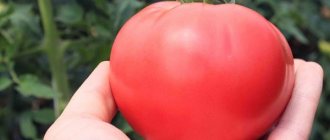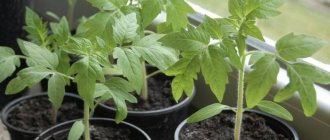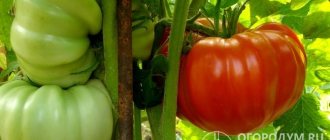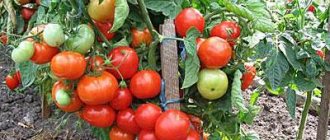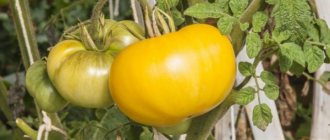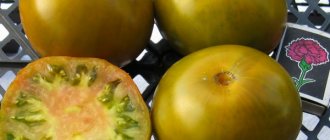Description of the tomato variety Yellow Giant
An indeterminate, tall tomato bush, the Yellow Giant grows from 160 cm and above. The stems are densely leafy and strong; dark green leaves are large, of the usual type. The Yellow Giant bush can produce up to 10 fruit clusters on 2 stems. From each inflorescence 3-6 ovaries are formed.
The fruits are round, flattened, slightly ribbed. On average, weighing 250-350 g. The dark green spot at the stalk is faintly visible when fully ripe. The skin is thin, but quite dense, does not crack, and is yellow in color, as is the fleshy, juicy pulp. The Yellow Giant tomato has many seed chambers, they are filled with juice, but there are a limited number of seeds.
The fruits of the mid-season variety ripen 110-120 days after the sprouts appear. Thanks to the high stem, where the fruit clusters are formed in stages, the fruiting of the Yellow Giant is long, up to 1.5 months. Large tomatoes with fleshy and juicy pulp are not intended for long-distance transport. Ripe fruits will also not last long. Tomatoes picked before they are fully ripe are ripened and can be stored in the refrigerator for up to 2 weeks.
Varietal characteristics
This tomato is an indeterminate plant with mid-ripening fruits; the height of adult bushes is 1.2 - 1.7 meters. Tomatoes are large and yellow in color when ripe. Tomatoes are classified as a salad variety, but can be used for canning by cutting them into slices.
From the moment of sprouting until the first harvest of tomatoes is harvested, 110–122 days should pass. The yield is up to 5.5 kg from 1 bush.
A positive characteristic of the variety is that fruiting lasts 1.5 months. The fruits can reach a weight of up to 400 g with proper care. The shape of the Yellow Giant Tomato is round, slightly flattened, and has a sweetish, honey-like taste.
The description of the variety shows that this giant tomato is not contraindicated for allergy sufferers; it is recommended for baby food, the weak and the elderly. The presence of a large amount of niacin in tomatoes helps strengthen blood vessels and normalizes heart function. Yellow tomato has a positive effect on the liver, kidneys and gastrointestinal tract.
Pros and cons of Claude Brown's Yellow Giant tomato variety
Judging by the reviews, photos and high yield of Yellow Giant tomatoes, the variety is quite popular. Claude Brown's Yellow Giant tomatoes, first bred in Kentucky, USA, have a number of advantages:
- high-yielding;
- large-fruited;
- with long-term fruiting;
- delicious;
- It is believed that tomatoes with yellow flesh are less aggressive as a source of allergens, but contain more lycopene, and are also not as acidic as red fruits.
The disadvantages include:
- the need for pinching and tying up tall bushes;
- low transportability;
- average susceptibility to pathogens of fungal and viral diseases.
Advantages and disadvantages of the variety
The yellow giant is grown in different regions. The most common tomato is in the Volga, Ural, and Southern districts.
The Yellow Giant produces maximum yield in the southern regions
pros
- high productivity;
- large fruits;
- excellent taste;
- many vitamins and other useful elements
- long fruiting;
- cultivation both in greenhouses and in open ground;
- You can propagate yourself by seeds.
Minuses
- need to be tied up and stepsoned;
- susceptibility to viruses and fungi;
- fruits are not suitable for long-term storage and transportation.
Growing
Vigorous bushes of this variety with large fruits require careful care for the plant to reach its potential. Seeds are harvested from the fruits independently, choosing the largest and smoothest specimens.
Advice! Tomato seeds for seedlings are sown 60-70 days before moving to the beds or to the greenhouse.
Growing seedlings
For large-fruited tomatoes, the substrate is enriched before sowing by adding mineral fertilizers to humus, peat and garden soil taken equally:
- urea;
- potassium sulfate;
- superphosphate.
Take a teaspoon of each drug per 10 liters of substrate.
Seeds are also treated:
- soak for 15 minutes in a light pink solution of potassium permanganate, rinse under the tap and dry;
- Before sowing, growth stimulants are used, following the instructions.
Sow to a depth of 0.6-1.2 cm, slightly compacting the grains into the soil, cover the container with film and place in a warm place - 23-25 °C. As soon as the sprouts sprout after 6-8 days, the film is removed and the container is transferred to a bright room with a moderate temperature, 18-20 °C, for 7-8 days. During this time, the shoots become stronger, the stems thicken, but do not stretch upward. Then the tomatoes are placed at a temperature comfortable for the culture, above 23 °C. With the appearance of the 2nd true leaf, the tomatoes are plucked and transplanted into separate cups with a diameter of 6-8 cm. The seedlings are watered moderately, and additional lighting is provided with full daylight hours.
Landing rules
1.5-2 month old seedlings with 9-12 leaves are planted. Tall tomatoes are placed every 70 cm. The hole is made spacious so that the root system of the tomato can fit freely in it. Each hole is watered with 1 liter of water and 1 tablespoon of ammonium nitrate is added. Peat pots with tomatoes are placed entirely in the hole. From other cups, well spilled in advance, the earthen lump is carefully released and slightly deeper into the wet soil, sprinkled with soil and compacted. Immediately install supports, retreating 15 cm from the stem.
Comment! In the garden, tomatoes are planted in areas where onions, zucchini, cabbage, cucumbers or legumes were grown in previous years.
Watering and fertilizing
After 5 days, the tomatoes are watered with warm water infused in a greenhouse or in the sun. Watering is carried out in the evening, trying not to spray the leaves of the plants. Tomatoes are watered abundantly in the phase of creating buds, before flowering, and also during the period of fruit growth.
Important! Each plant is given at least 1 liter of water, and with development - up to 2-3 liters, so that the moisture reaches the entire root system.
Fertilizing is also important for tomatoes at these stages of development. Before each fertilization, the soil is moistened abundantly so that the nutrients are easily absorbed by the plants. First, they are fed with preparations with a predominance of nitrogen for the growth of green mass. Organic matter is often used as the first fertilizer. The second and third feedings support the plant, which begins to form fruits and needs potassium and phosphorus, so choose products with a higher percentage of these minerals. It is convenient to use special mineral complexes for tomatoes with micro- and macroelements. For higher yields, the use of foliar fertilizers based on boric acid is popular.
Pinching and tying
Vigorous bushes take stepson once a week, tearing off branches that form along the stem in the axils of the leaves. Gardeners believe that such shoots should not be allowed to grow large and should be broken off at a length of 3-4 cm. At the same time, a small stump is left on the stem so that a new shoot does not form. As the stems grow, they are tied to trellises, using light and soft material that does not injure the delicate tissues of the tomatoes.
Formation
Tall, large-fruited tomatoes have 2 stems. The second trunk is formed from the first or second stepson and tied to a trellis. Sometimes the number of ovaries in the fruit cluster is normalized if there are more than 6. The remaining flowers are pinched off. To get especially large fruits, remove 2-3 tomatoes, leaving only 2-3 fruits on one bunch. 1.5 months before the end of the warm season, the tops of indeterminate tomatoes are pinched, stopping the growth of the bush.
Protection from diseases and pests
Yellow Giant bushes are susceptible to some fungal and viral diseases, therefore preventive treatment of tomatoes with fungicides or folk remedies is recommended. Pre-sowing seed treatment is the beginning of protective measures to prevent diseases. Good results are achieved by treating tomatoes with Fitosporin, Maxim and others, which are used strictly according to the instructions.
The Colorado potato beetle may fly onto the planted seedlings. The bushes are checked daily, also inspecting the underside of the leaves. Aphids and whiteflies can be controlled using traditional methods and following a schedule of watering and ventilation of the greenhouse.
How to grow seedlings
Yellow giant seeds are germinated 2 months before planting in open ground. In the southern regions they begin to do this in the last days of February, in the central regions - in the second half of March.
Some gardeners advise planting seeds according to the lunar calendar. Plants that began to grow on a suitable lunar day will be stronger and healthier.
Seed preparation
To test the seeds for germination, they are soaked in a salt solution for half an hour. To prepare the product, dissolve 0.5 teaspoons of salt in 100 ml of water. Those specimens that float to the surface are unsuitable for planting.
If purchased tomato seeds were used, then most likely they will be treated at the factory. Information about this is indicated on the packaging.
Planting material obtained from its own fruits is disinfected. It is soaked:
- for 30 minutes in a light pink solution of potassium permanganate;
- for 15 minutes in hydrogen peroxide;
- for 12 hours in aloe juice diluted with water (1:1);
- for 12 hours in a soda solution (1 teaspoon of soda per 1 cup of water).
Next, seed germination is stimulated by soaking them in nutrients:
- "Epine";
- sodium humate;
- "Effectone";
- ash solution (1 tbsp. ash per 1 tbsp. water);
- honey solution (1 teaspoon of honey per 1 cup of water).
Selection of containers and soil
Any wide containers are suitable for sowing seeds. Plant seedlings into pots with a volume of at least 300 ml.
Growing containers are disinfected. They are soaked for 30 minutes in a dark pink solution of potassium permanganate.
You can buy the soil at the store or prepare it yourself. In the first case, choose special soil for tomatoes and peppers or a universal seedling mixture.
It is not difficult to prepare the soil yourself. To do this take:
- 1/3 bucket of peat;
- 1/3 bucket of humus;
- 1/3 bucket of garden soil;
- 1 teaspoon each of superphosphate, urea and potassium.
All ingredients are thoroughly mixed. Then the soil is watered with a strong solution of potassium permanganate or calcined in the oven.
The best containers for seedlings, what volume for early sowing tomatoes
Sowing
Soil is poured into the box and watered with warm water. Furrows are made in the soil 1 cm deep at a distance of 4 cm. Seeds are placed in them at intervals of 2 cm.
The grooves are sprinkled with earth and moistened with a spray bottle. The containers are covered with film and placed in a warm place.
Seedling care
To grow healthy seedlings, you need to properly care for them. The list contains the main recommendations:
- After the first shoots appear, the film is removed. Plants are moved to a well-lit place.
- Water the seedlings as the soil dries out. For irrigation, use liquid at room temperature. It should not get on the above-ground parts of plants.
- When real leaves appear, the tomatoes are planted in individual pots. Fine crushed stone or broken ceramic dishes are poured into the bottom of the containers as drainage.
- 2 weeks after transplantation, the tomatoes are fed and watered for the first time.
- In total, during the growing period, 3 feedings are applied with a break of 2 weeks. Complex mineral fertilizers and vermicompost are used.
- 10 days before planting tomatoes in a permanent place, they begin to harden. The seedlings are taken out onto the balcony or street. The procedure begins at 1 hour, gradually increasing the time to 16 hours.
Yellow Giant
The Yellow Giant variety has been on the State Register since 2015. It belongs to the mid-season group. Ripening of tomatoes in an open garden bed occurs after 115 days.
When grown in a summer greenhouse, tomatoes ripen 2 weeks earlier. The bush is determinate, but tall. It can rise up to 1.2 m. In an open area, seedlings are lower. Their average height is 1 m:
- The fruits are flat-round, rich yellow in color. The ribbing shows up well. From a distance, tomatoes look like small pumpkins. The pulp is juicy, but holds its shape well;
- a weight of 250-300 g is considered commercial, but, according to reviews from private growers, the Yellow Giant tomato can gain up to 700 g;
- in an open garden, fruits pick up more sugars. It is recommended to provide an area for them that is well lit all day;
- the yield is 9 kg/m2, but gardeners claim that this amount of tomatoes can be harvested from one bush;
- the tomato does not get sick, but only if the rules of agricultural technology are observed. Plants are treated against infections once every 3 weeks.
The Yellow Giant variety is grown in a fertile garden bed. In the fall, it is enriched with organic fertilizers. In spring, mineral complexes are added. Ash is used as a fungicide. To prevent insects from emerging from the soil in early spring, “Neoron” or “Nitrophoska” is added to the garden bed.
More on the topic: What varieties of raspberry-colored tomatoes exist?
Tomatoes are grown from seedlings 55 days old. Sowing is carried out 65-70 days before the intended planting in the ground. For seedlings, the correct temperature and daylight hours are observed.
Yellow Giant is a varietal plant; you can collect seed material yourself, but there are some nuances when growing tomatoes.
If you plan to collect seeds from tomatoes, it is not recommended to use ovary and growth simulators. Tomatoes develop better, but daughter plants may bear deformed, ugly fruits.
Otherwise, the root of the seedlings will not form well enough, which will affect fruiting and the quality of the fruit.
Prevention of diseases and pests
Although the bushes look very strong, they are not resistant to diseases. Tomatoes of this variety are most susceptible to the following diseases: late blight, Alternaria blight, tobacco mosaic and other diseases that affect nightshade crops. Reviews from gardeners indicate the need for preventive treatment with fungicides.
The variety is highly resistant to most pests and diseases. It is only affected by late blight, tobacco mosaic and the Colorado potato beetle.
To combat late blight, the drugs “Ordan”, “Barrier”, “Zaslon” are used. They are processed before the flowering period begins. When the first ovary appears, you should use a 1% solution of potassium permanganate mixed with a glass of ground garlic (0.5 liters per 1 square meter).
If the plant is completely affected by the disease, then it is easier to tear it out and burn it.
To reduce the likelihood of a plant becoming infected with tobacco mosaic, the seeds should be treated with a 1% solution of potassium permanganate before planting. If the disease has just begun to manifest itself, the affected leaves are torn off and burned. In case of severe damage, the bush is pulled out and burned outside the site.
The Colorado potato beetle attacks only young seedlings. The fight against it begins at the moment the first beetles appear in the garden; in this case, the same means are used as for potatoes. It is best to spray with biological products “Bitoxibacillin”, “Colorado”, “Fitoverm”, “Bikol”.
The variety quite often suffers from late blight, tobacco mosaic and cladosporiosis.
To reduce morbidity, it is recommended to follow preventive measures:
- Change the top layer of soil in the greenhouse annually;
- Avoid dense plantings;
- Trim off the lower leaves to improve ventilation of the bed;
- Choose a balanced watering regime, in which moisture penetrates 30 cm into the ground, but does not linger in the garden bed;
- Periodically spray the bushes with garlic infusion.
Tomato Honey Giant - description and characteristics of the variety
The Honey Giant tomato variety belongs to the indeterminate type. The bushes reach a height of 120 to 200 cm. Fruiting is mid-early, beginning 100-110 days after sowing.
A tall bush produces 6-7 fruit clusters, each of which contains 3 to 6 tomatoes (to obtain larger ovaries, they are normalized).
Tomatoes of this variety have a round, slightly flattened shape. Fruit weight is from 350 to 600 g. The skin color is yellow-orange, the flesh is pinkish. The taste is very sweet, with a light fruity aroma.
The fruits are consumed fresh - in salads, slices and as a snack. They are not suitable for whole canning because they are too large. However, they can be used for mixed vegetables or winter salads.
Advantages
It is worth noting that growing this variety has many advantages. These are advantages such as:
- high productivity;
- excellent taste;
- the ability to carry out transportation if necessary;
- excellent keeping quality (tomatoes can be stored for a long time);
- high resistance to various types of bacteria and diseases;
- Tomatoes tolerate both heat and cold well.
Flaws
According to the descriptions, only two stand out among the shortcomings. The first of them can be considered universal, since it concerns not only the Honey Giant, but also other varieties of tomatoes.
We are talking about the need to carefully care for plants and bushes that need close attention.
Relative whimsicality is a completely normal phenomenon, therefore, if a gardener wants to get really large fruits, he will have to try for this.
The second disadvantage can be considered tall bushes, which are covered with large fruits and can easily break under the weight of ripe tomatoes. In this case, the best option would be supports or trellises that can be used to hold the plants.
Landing rules
The soil for planting must be well prepared
To plant Honey Giant tomatoes, you will certainly need well-fertilized, fertile soil. To obtain a high-quality harvest, it is necessary to prepare the soil by digging it well and fertilizing it. During autumn digging, you need to supply the soil with a mixture of lime (0.5 kg), manure (5-7 kg) and superphosphate (60g).
In the spring, it makes sense to fertilize the soil again, enriching it with nitrogen or potassium mixtures. 60-65 days before planting, seedlings must be placed in special containers. With the onset of warmth, plants are placed according to the following scheme: 4 bushes per 1 m2 The process of planting seedlings is very simple:
- a hole is made at least 20 cm deep;
- a seedling is carefully placed at the bottom of the hole;
- plants need to be watered;
- The hole with the seedling must be sprinkled with earth.
Prevention and control of diseases
Despite the high resistance characteristics of the variety, Honey Giant tomatoes require preventive measures: correct crop rotation will help to avoid late blight and other fungal diseases.
Universal preventive measures include: regular ventilation, loosening, weeding, mulching, timely fertilizing, removing the lower leaves from the bush.
Preventive spraying (Bordeaux mixture, calcium nitrate, kefir, garlic infusion, copper sulfate) helps against rot and other fungal diseases.
Insect pests need to be washed off the leaves with a soap solution and sprayed with biological products or insecticides.
Tomato Honey giant. Aelita
The most delicious yellow-fruited tomatoes.
Tomato Honey giant. Aelita
In addition to this product, you can also use mustard or ground pepper, which is diluted in the proportion - 1 spoon per 10 liters of clean water
The resulting composition must be sprayed with great care so as not to damage the leaves of the plant, so this procedure is done either early in the morning or after sunset
Another problem that may arise is a whitefly infestation. It is usually combated thanks to a drug such as Confidor. The characteristics of the variety confirm that this is an excellent choice for any gardener; the main thing is to know how to properly care for it.
